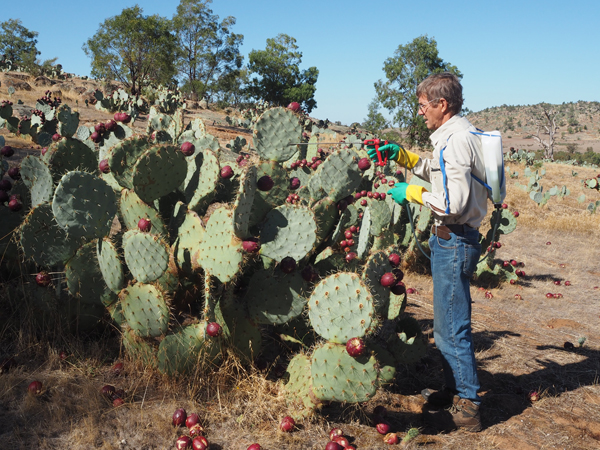Mapping a ‘wheely prickly’ problem
By Lee Mead, President of Tarrangower Cactus Control Group Inc.
In the 1990s, community members around Maldon, Victoria became alarmed at the invasion of Wheel Cactus (Opuntia robusta) on their properties and historic landscapes. By 2005, members of three local Landcare groups formed the Tarrangower Cactus Control Group (TCCG), specifically to focus on control of this highly invasive plant. Ian Grenda, a founding member and former president, explained that, “Neighbouring farmers and townsfolk realised what a serious threat wheel cactus posed to their land, livelihoods, parks and well-being,” so they got together to do something about it.
Since then, the ‘cactus warrior’ volunteers have been informing, demonstrating and assisting local landowners to control wheel cactus infestations on their properties. “We’ve held regular community field days on both private and public land and provide incentives, such as free loans of injecting and digging equipment and free disposal of plants at the local tip,” said Ian.
Current president of the group, Lee Mead, said, “Our group has significantly increased awareness of the threat of wheel cactus within our community over the past decade by creating and distributing brochures, publishing regular media releases, and creating a dedicated website, www.cactuswarriors.org.”

Cactus Warrior Ian Grenda demonstrating how to inject Wheel Cactus plants with herbicide.
“Participating in local events such as the Maldon Easter Fair parade and the annual Agricultural Show also effectively increases our plight and profile,” she added.
However, despite increased numbers of local landowners who now quietly go about destroying wheel cactus on their properties, there are still many property owners in the district who ignore their responsibilities to destroy noxious weeds, Lee told Landcare in Focus. “Most often, these are absentee landowners who are very difficult for our volunteer group to connect with,” she said. Hence, the seed bank is never eradicated and new wheel cactus plants continue to germinate and invade the environment.
The TCCG continues to seek improvements in control and management strategies and believe that these non-complying properties need some form of enforcement. In an attempt to discover how prevalent and widespread wheel cactus has become in Victoria, the group has gained valuable funding from the Norman Wettenhall Foundation to map wheel cactus infestations within the state.
Max Schlachter, the project officer collecting information and creating a map, said, “We welcome reports from everyone who has seen wheel cactus growing anywhere in Victoria. Simply send a photograph of the plant (for verification) and description of the locality to [email protected]. We hope to compile this map by June 2017 and then use this data to seek further support from government and funding bodies to control the invasion of wheel cactus.”
For more information about Wheel Cactus, contact the Tarrangower Cactus Control Group Inc. at [email protected].



